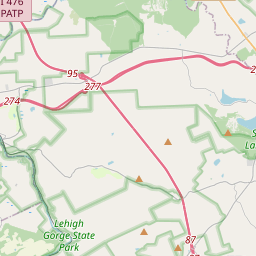Easton and Wilkes-Barre Turnpike
Historical marker location:
5636 PA Route 115, Blakeslee, Pennsylvania
( Marker is on PA Route 115 (Pennsylvania Route 115) ½ mile south of PA Route 940 (Pennsylvania Route 940), on the left when traveling south.)
Marker installed: 2017







© OpenStreetMap contributors
Pennsylvania was the site of the deadliest nuclear accident in U.S. history. In 1979, a partial meltdown occurred at the Three Mile Island nuclear power plant in Harrisburg, Pennsylvania.
About Monroe County
Monroe County Timeline
Monroe County, located in northeastern Pennsylvania, has a rich history that stretches back centuries. The area was originally inhabited by Native American tribes, including the Lenape and Shawnee, who utilized the region's lush forests and abundant wildlife. European settlers began to arrive in the mid-18th century, establishing farms and small settlements. One of the earliest pioneers was a man named Jacob Stroud, who established the town of Stroudsburg in 1799.
During the American Revolution, Monroe County played a significant role as a strategic location between the patriot-controlled Philadelphia and the British-controlled New York City. The region witnessed several skirmishes and battles, including the notable Battle of Wyoming in 1778, where American forces clashed with British and Native American allies.
In the early 19th century, the completion of the Delaware and Hudson Canal in the 1820s brought an economic boom to Monroe County. The canal, which connected the coal mines in northeast Pennsylvania to the Hudson River in New York, facilitated the transportation of coal and other goods, leading to the growth of the county's population and economy.
The late 19th and early 20th centuries saw Monroe County transform from an agrarian society to a resort and recreational destination. The natural beauty of the Pocono Mountains attracted visitors from Philadelphia and New York City, prompting the development of hotels, resorts, and vacation homes. Today, Monroe County continues to thrive as a popular tourist destination, offering outdoor recreational activities, historic sites, and a vibrant arts and cultural scene.
During the American Revolution, Monroe County played a significant role as a strategic location between the patriot-controlled Philadelphia and the British-controlled New York City. The region witnessed several skirmishes and battles, including the notable Battle of Wyoming in 1778, where American forces clashed with British and Native American allies.
In the early 19th century, the completion of the Delaware and Hudson Canal in the 1820s brought an economic boom to Monroe County. The canal, which connected the coal mines in northeast Pennsylvania to the Hudson River in New York, facilitated the transportation of coal and other goods, leading to the growth of the county's population and economy.
The late 19th and early 20th centuries saw Monroe County transform from an agrarian society to a resort and recreational destination. The natural beauty of the Pocono Mountains attracted visitors from Philadelphia and New York City, prompting the development of hotels, resorts, and vacation homes. Today, Monroe County continues to thrive as a popular tourist destination, offering outdoor recreational activities, historic sites, and a vibrant arts and cultural scene.
Monroe County Timeline
This timeline provides a glimpse into the major events and milestones that have shaped the history of Monroe County, Pennsylvania.
- 1725 - Monroe County is formed as part of Bucks County in Pennsylvania.
- 1836 - The county is officially established and named after James Monroe, the fifth President of the United States.
- 1865 - The county experiences growth and development due to the arrival of railroads.
- 1978 - Delaware Water Gap National Recreation Area is established, preserving a large portion of Monroe County's natural beauty.
- 1990s - The county sees an increase in population and development, becoming a popular residential area.
- 2008 - The county experiences rapid growth in the tourism industry, thanks to its proximity to the Pocono Mountains.